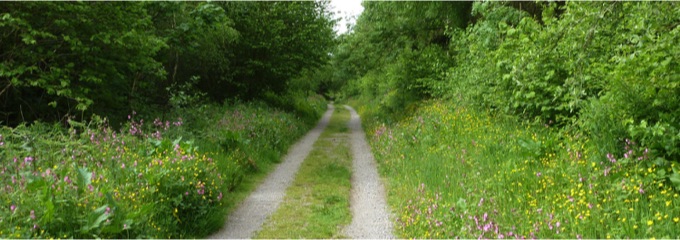Bats
There are 18 species of bats in the UK, 11 of which have been recorded at Coed Craig Ruperra. These are:
Lesser horseshoe bat (Rhinolophus hipposideros)
Greater horseshoe bat (Rhinolophus ferrumequinum)
Daubenton's bat (Myotis daubentonii)
Whiskered bat (Myotis mystacinus)
Brandt's bat (Myotis brandtii)
Natterer's bat (Myotis nattereri)
Brown Long-eared bat (Plecotus auritus)
Common pipistrelle (Pipistrellus pipistrellus)
Soprano pipistrelle (Pipistrellus pygmaeus)
Noctule (Nyctalus noctula)
Serotine (Eptesicus serotinus)
In the nearby Ruperra castle is a maternity roost of Greater horseshoe bats - one of the largest and rarest bats in the U.K. It is one of only five such roosts in Wales and the only one in south-east Wales. The woodland is important to the bats for foraging and it is for this reason that both the castle and our woodlands were declared a Site of Special Scientific Interest (SSSI) in 2011.
Other bats breed in the woodlands and we have put bat boxes on some of the larger trees and these are checked twice a year. You need a good head for heights on these surveys! Not all bats will use boxes, as some of them have different requirements and prefer caves, or buildings such as old barns, but we do find pipistrelles in our boxes.
Every summer, Ruperra volunteers lead guided bat walks, and on these you can learn to indentify some of the different species with the help of electronic bat detectors. These allow us to hear the very high-pitched ultrasonic sounds that bats use while foraging, and different species tend to have different characteristic calls. For more details of these bat walks see our events page.
Hazel Dormouse
Most people nowadays are unlikely to encounter a hazel dormouse and the reasons are simple. Firstly, they are an increasingly rare species, due to loss of their favourite habitat, which is hazel woodland with plenty of connecting branches between trees, or hedgerows which allow them to travel safely along feeding routes. Secondly, they are nocturnal and come out at night to feed on berries, seeds and insects. Finally, they are arboreal, preferring to travel off-ground via branches and foliage. They avoid being on the ground whenever possible, where they are more vulnerable to predation by owls and larger mammals such as foxes.
Fortunately, their numbers can be monitored by providing them with nest boxes. In these, they will happily make a small nest woven out of honeysuckle bark or similar materials, topped with fresh leaves taken from the canopy above. Sometimes the nest is simply a looser overnight ‘motel’ which the animal will use occasionally while travelling round its foraging area. However, the females will make a more substantial woven nest in which they have their family of up to six or seven babies. Dormice are not territorial, and when we check the nestboxes on our monthly surveys, we often find two or even three happily occupying the same box.
The dormouse gets its name from the French verb, dormir which means ‘to sleep’. One of its old country names was ‘Seven-sleeper’, reflecting its habit of sleeping during the day in summer and also hibernating through the winter. Effectively this means it is asleep for virtually seven months of the year! It is one of only a few animals in Britain that hibernates (others include Hedgehogs, all bat species and amphibians like toads and frogs, as well as reptiles such as slow worms).
However, the dormouse snoozing in its nest on a summer day is not just asleep as we know it. Like bats, the dormouse feeds at night, then goes into what is known as ‘torpor’. This is a deep sleep, more like a comatose state, from which the tiny animal wakes only slowly, and it is then that it is most at risk from predators. The benefit for us, is that when we survey our nestboxes, a dormouse in torpor can be weighed, sexed and replaced in its box without even waking up – which is why we have some great photos of them!
Dormice are, however, a protected species. It is against the law to disturb them or their nests without a licence, so if you do see a nestbox on your walk around our woodland or anywhere else, please stay well away from it!
Mammals
Grey squirrels are probably the most obvious mammals when you visit the woods but most of our mammals are nocturnal, although they can sometimes be spotted early in the morning or at dusk.
The following mammals have been recorded at Coed Craig Ruperra:
Hazel dormouse (Muscardinus avellanarius)
Common shrew (Sorex araneus)
Pygmy shrew (Sorex minutus)
Bank vole (Myodes glareolus)
Field vole (Microtus agrestis)
Wood mouse (Apodemus sylvaticus)
Harvest mouse (Micromys minutus)
Brown rat (Rattus norvegicus)
Grey squirrel (Sciurus carolinensis)
Rabbit (Oryctolagus cuniculus)
Brown hare (Lepus europaeus)
Badger (Meles meles)
Polecat (Mustela putorius)
Stoat (Mustela erminea)
Weasel (Mustela nivalis)
Mole (Talpa europaea)
Fox (Vulpes vulpes)
Hedgehog (Erinaceus europaeus)
Bats (see below)


Greater horseshoe bat
(Photo courtesy of the Bat Conservation Trust)
Checking one of our bat boxes



Dormouse nestbox - the hole is next to the tree trunk
A dormouse nest constructed of woven strips of bark
Three sleepy dormice

